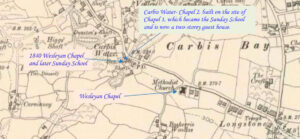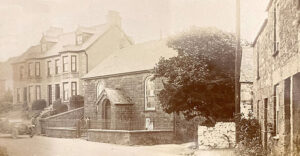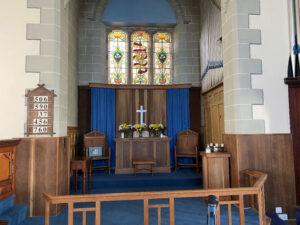
Carbis Bay lies 1 mile (1.6 km) southeast of St Ives on the western coast of St Ives Bay. This profile of Carbis Bay Wesleyan Chapel has been compiled by Val Thomas of St Ives Old Cornwall Society.
This area of what we now know as Carbis Bay used to be referred to as Uny, Lelant, as Lelant was where the mother Church was situated. Uny, Lelant, or Carbis Bay, as we now call it, was subdivided into various hamlets such as Chyangweal, Trewartha, Carninney, Boskerris, Longstone etc. These hamlets have now been developed and the whole area has lost many of the names of the original settlements unless they are referred to in the names of new developments such as Boskerris Close.
There are references to chapels or meeting places in Longstone, which is mentioned in the booklet ‘History of the St Ives Fore Street Methodist Church’. The records mentioned for this meeting place are from 1873 to 1876 when it was closed. The date of closure corresponds with the closure of the Wheal Providence mine at Carbis Bay which threw hundreds of men out of work and led to wholesale emigration from the area.
There is also mention in the booklet of another meeting place at Chyangweal which was not, apparently, connected to the chapel which was built there.
Carbis Water was originally a small settlement which was built around the stream which ran through and from Wheal Providence mine, fording the road, to the sea.
1835 Chapel
1835. There was a small chapel at Carbis Water. It had seats for 142. In the book ‘St Ives Heritage’ by Lena and Donald Bray she states that joint open-air meetings for Methodists used to be held on the site where Chyangweal chapel now stands. She says the new chapel at Carbis Water was replaced 50 years later by a new one on almost the same site and the old chapel demolished. This tallies with my findings.
1837 William Burgess completed the census return.
1863 Trust accounts exist from this date for a Wesleyan Society n Carbis Bay.
1873 There were apparently 148 seats.
1881 March. According to ‘The Cornishman’ newspaper; “On Thursday last a public tea was provided in the Wesleyan chapel, Carbis Water; and in the evening a meeting of the Society was held, at which it was unanimously agreed to erect a new chapel.”
1886 Chapel
1886: Build date. (The Cornish Telegraph – Thursday 15 July 1886)
1886: Opening of new Carbis Water Wesleyan Chapel. (The Cornish Telegraph – Thursday 15 July 1886)
Built as a Wesleyan Chapel.
1885/6 A new building was erected on nearly the same site. This is the photo below. It was built by James Wallis and apparently cost£400. The fields opposite where the marquee was situated are now developed but would originally have overlooked the steep valley down to Carbis Bay beach which was then known as Barrepta.
 The 1885 small chapel at Carbis Water which has now been developed into a two-storey house with parking in front called ‘Thurlestone’. To the immediate right, as you look at it, is a small pathway. The next building to the pathway has been demolished and is now a letting agency with flat above. The cottages on the far right and houses on the left are still there and largely unchanged.
The 1885 small chapel at Carbis Water which has now been developed into a two-storey house with parking in front called ‘Thurlestone’. To the immediate right, as you look at it, is a small pathway. The next building to the pathway has been demolished and is now a letting agency with flat above. The cottages on the far right and houses on the left are still there and largely unchanged.
After building the new chapel nearby, this building was used as a Sunday school.
1885 August. Laying the memorial stones for the new chapel erected on the site of the old one.
The West Briton and Cornwall Advertiser August 13, 1885. “New Wesleyan Chapel at Carbs Water. Address by Sir John St Aubyn, Bart, MP. Memorial stones of a new Wesleyan chapel at Carbis Water, near St Ives, were laid on Thursday by Sir John St, Aubyn, Bart, MP; Mr J.T. Matthews, of London; and Mr W. Craze of Liverpool. The new chapel is being erected on the site of the old one. It will cost £265 and is estimated to seat 225. Mr J. Wallis, St Ives is the contractor. The proceedings were greatly interfered with by the rainy weather.” Etc.
Methodist chapel. Probably circa 1900. Rock-faced granite brought to course and contrasting white granite dressings; dry slate roofs with crested clay ridge tiles except for steep slate roof to octagonal spire surmounted by finial. Strongly articulated plan form in the mid Gothic style. Buttressed entrance gable end has large 4-light traceried window over doorway with pointed ordered arch and flanking trefoil lights. Low forecourt walls and iron railings and broad flight of granite steps up to doorway. (Cornish Heritage Gateway)
The Cornish Telegraph of Thursday the 15th July 1886 reported on the opening of the new chapel.
- “Carbis Bay Wesleyan Chapel has recently undergone thorough renovation …” There was a new harmonium and the collection amounted to £7. Weekly Summary and Visitors List, June 27th 1891.
In the same newspaper on the 3rd March there was a request for a new road to Carbis Bay Railway Station. “Cannot our Member induce the County Council to sanction the construction of a new road from Carbis Water Chapel along the brow of the croft to the Station? At present, as you are aware, the only way we can get there is by going out to Longstone and turning down a narrow lane, so badly kept that after heavy rain it is almost impassable.”
1897: Mr Francis Rosewarne, mining engineer, from Longstone, Carbis Bay died age 30 after a few years working in South Africa. Mrs Rosewarne donated a baptismal font in his memory. It was usually kept on the Communion Table. It had a base of marble with four serpentine pillars with a serpentine font bowl from Cornwall. Rich gilt lettering on the front say: “This font is presented to the Society in loving memory of Francis Richard Rosewarne by his beloved wife, Annie Rosewarne. He died 15th March 1897 aged 30. Trusting in Jesus.” Mr Pascoe of Penzance supplied the handsome font.
1903 This chapel became the Sunday-school building. The Sunday-school treats for this chapel were traditionally held at Mr Payne’s Tea Gardens in Carbis Valley, above the railway station where the Cottage Hotel once stood and which is now a block of luxury accommodation. as he was a supporter of this chapel.
1910 July 2nd The Western Echo. A tender was in the newspaper for the erection of a small vestry and alterations to the schoolroom. Tenders to be in by July 11th! Mr J. Lander was accepting the tenders.
1928 December A concert was given by the St Ives Primitive Methodist choir in Carbis Bay Wesleyan Sunday-school aid of the renovation fund for Carbis Bay Sunday-school.
I have no date for the closure and redevelopment of this Sunday-school but it was probably around 1930/31 when the new Sunday school behind the Boskerris chapel was completed.
1903 Chapel
Positioned on a corner of the road below Higher Boskerris estate.
1902 Mr Tyringham gave the freehold of the land. The Western Echo, Saturday August 9, 1902.
A bazaar was held “with the purpose of raising funds for the erection of a new chapel. To meet the growing requirements of this popular seaside resort it is contemplated to erect a new building on a convenient site (which has been kindly given by R.W.G. Tyringham, Esq of Trevethoe) at a cost of about £1.500….”.
In a speech given by Mr Edward Hain he mentioned that the new chapel should be a structure of some architectural beauty… and something they could look upon with pride and satisfaction after they had erected it.
1903 July. “A new chapel was opened a little further along the road, just below Boskerris on the High ground overlooking the beautiful bay. It is of Gothic design with granite dressings with grey elvan stone. The tower at the north east rises to a height of 65 feet and in the main front are four windows of stained glass, given by the Dolcoath employees as a tribute of respect to their late manager, Captain Josiah Thomas. The three windows in the chancel were given by the children of Captain Josiah Thomas in memory of an affectionate mother Charlotte Augusta Thomas. The whole of the side windows are filled in with tinted glassing with original design. The chapel is cruciform in shape with two transepts. A brass communion rail denotes the entrance to the chancel. The communion cloth was covered in a scarlet cloth inscribed with the initials HIS. The new chapel has pitch pine seating and pulpit. It seated over 250 in comfort. The heating was done by waterpipes and ventilation was provided. The lighting was provided by six brass suspension lamps 100 candle-power each. The chapel is 55feet long by 34 feet wide. The transepts broke back from the main body by 7 feet. The chancel is 12 feet by 10 feet and the choir vestry 9 feet by 9 feet. The height internally is 26feet. Mr Glasson of Carbis Bay was the contractor and Mr Oliver Caldwell the architect. The cost of the building was about £1,800 exclusive of windows, which had been given. The chapel was opened by Miss Hain, daughter of Edward Hain MP. Miss Hain was given an inscribed silver key to open the door.”
Carbis Bay Wesleyans according to Lena Bray, had their own hymnist – Mr Thomas Ninnis Warmington of Longstone, a devoted member of the Boskerris congregation. He apparently composed Christmas Carols and was the grandfather of Bryan Pearce, the famous artist.
 Josiah Thomas’ memorial window as best it could be photographed in 2024. It was donated by the miners of Dolcoath in memory of their Captain. The miners also donated a window in his memory in Camborne Wesleyan Chapel where the family had their seaside home. (Image: Tony Mason 2024)
Josiah Thomas’ memorial window as best it could be photographed in 2024. It was donated by the miners of Dolcoath in memory of their Captain. The miners also donated a window in his memory in Camborne Wesleyan Chapel where the family had their seaside home. (Image: Tony Mason 2024)
 Memorial window to Charlotte Augusta Thomas, presented by her children in memory of their mother. (Image: Tony Mason 2024)
Memorial window to Charlotte Augusta Thomas, presented by her children in memory of their mother. (Image: Tony Mason 2024)
All the side windows were presented by Fred Thomas and his wife. He was the son of Josiah and Charlotte Thomas.
At one time Carbis Bay was known as Camborne by the sea as many Camborne miners bought second homes for the fresh air.
 The Carbis Bay Wesleyan chapel opened in 1903. (Image; Steve Prescott)
The Carbis Bay Wesleyan chapel opened in 1903. (Image; Steve Prescott)
“Carbis Bay Chapel circa 1903 or very soon afterwards, showing the newly built Carbis Bay Wesleyan Chapel, which lies on the southern side of the road between Lelant and St Ives.
What is striking about this image is that the chapel stands alone, unlike today with houses very close by. The card is entitled on the reverse side in pencil ‘ Carbis Water Chapel’ rather than Carbis Bay. A very sharp early Edwardian image of a pleasing building in the Gothic style with finely cut granite dressings.” (David Thomas)
In this early image of the chapel it stand alone above the road below, unlike now when it is surrounded by properties.
1905 one of the coloured memorial windows in the chapel was broken by a stone being thrown. A reward was offered for information.
- the first wedding took place between Miss Ethel Vivian and Mr Harrold Morgan Williams of Cardiff.
1923 November The Carbis Bay Wesleyan Church was reopened after renovation.
1930 December 11 The Cornishman and Cornish Telegraph The stone laying for the new Wesleyan Sunday school took place on Thursday afternoon. Stones were laid by the Mayor of St Ives (Mr W Craze), Rev H A Swanborough on behalf of Mrs Hendra, Capt E R Care on behalf of Mrs Hosking, Mr W J Jacobs JP, Little Rosemary Tancock, Mrs Lanyon, Mr R Dudley, Mrs Marshall and Miss Withington. Howard Dunn, Muriel White, Mary Dunn, Garner Pearce, Patricia Augusta Taylor, John Payne, Richard Denis Penberthy, John C Angwin, Edith Elizabeth Toms, John R Warmington, Cecil Edward Laity, Barbara Toms, Brian Pearce, Daphne Toy, Raymond Scott Brown and Phyllis Marjorie Trewhella were the children who also laid stones.
This must be the big building behind but attached to the Carbis Bay Methodist Church which is accessed by the side door to the left and along from the main door to the church.
1932: The Wesleyan, Primitive Methodist and the United Methodist Church amalgamated to become the Methodist Church of Great Britain.
1932: Became Carbis Bay Methodist Church.
1937 July 8 The Cornishman and Cornish Telegraph.” ‘The Carbis Water’ banner from the old Sunday-school was displayed in the rostrum” of the new Carbis Bay Wesleyan Church.
1938 July21st Cornishman newspaper. Next year will be the 100th anniversary of the Carbis Water Sunday-school at Carbis Bay. On Sunday there were special anniversary services in which the Chyangweal friends and children also took part. The Sunday-school treat that year was at Perranporth.
1942 Mrs Warmington, who had attended Trevarrack Day School as a child, mentioned in part of a memoir that when she was a child there were only a few small houses in Carbis Bay, which was then known as Longstone Downs with Carbis Water at the St Ives end of it. Three Methodist Sunday Schools had succeeded each other, one built on the site of the first schoolroom.
1943 Good Friday; April. The chapel held a fundraising to reduce the debt on the Sunday-school. The family of the late C V Thomas of Camborne had initially loaned the money.
This is the new flat roofed building, built in 1930, which is behind the original granite building with the tower.
2010 The St Ives Archive moved their collection and information desk into the Sunday-school rooms at the back of the chapel.
2024 The St Ives Archive are shortly to move into new premises in the old Town Hall in the middle of St Ives.
2024 The Sunday-school room is used by the St Ives Archive. It has been used for Carbis Bay Brownies and children’s parties among other uses in the past.
2024 United Beach Missions (UBM) is based at Carbis Bay Wesleyan Church. They arrive in St Ives during the Summer and use the beaches to promote their message. The volunteers use Chyangweal Chapel for some of their accommodation.
There are many records for this Chapel/Church at Kresen Kernow.
Resources.
Tony Mason – St Ives Archive Trustee
Brian and Margaret Stevens -St Ives Museum
Find My Past newspaper articles, particularly the Western Echo and The Cornishman
National Maps of Scotland
David Thomas
St Ives Heritage – Lena and Donald Bray
Mary Quick
